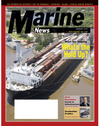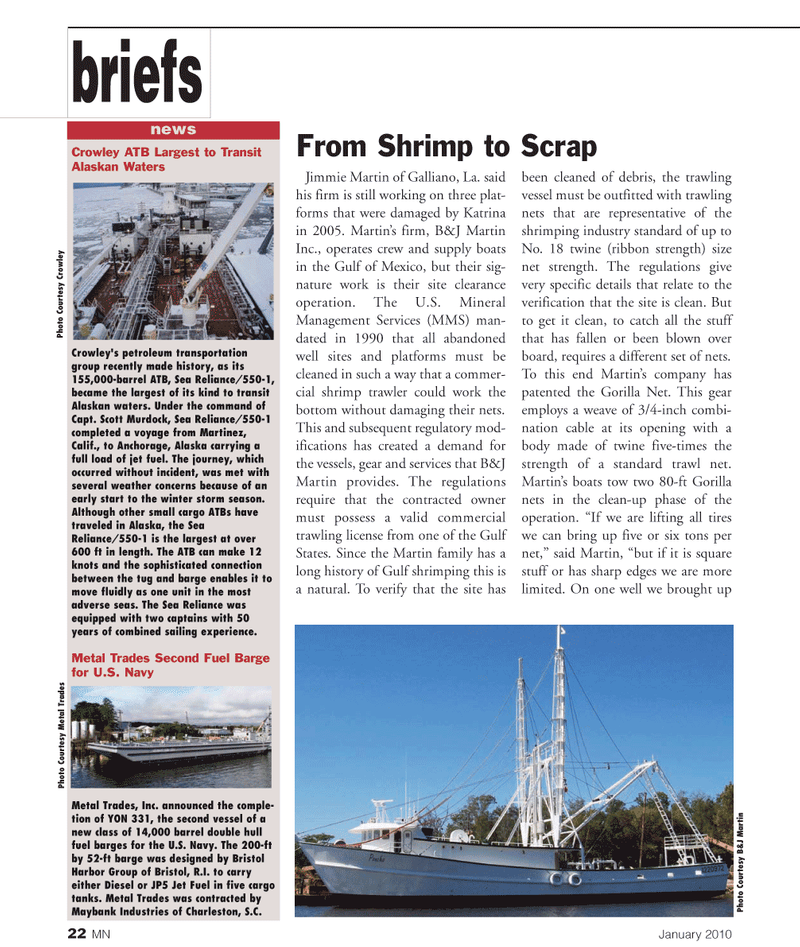
Page 22: of Marine News Magazine (January 2, 2010)
Read this page in Pdf, Flash or Html5 edition of January 2, 2010 Marine News Magazine
22 MN January 2010 briefs
From Shrimp to ScrapCrowley ATB Largest to Transit
Alaskan Waters
Crowley's petroleum transportation group recently made history, as its 155,000-barrel ATB, Sea Reliance/550-1, became the largest of its kind to transit
Alaskan waters. Under the command of
Capt. Scott Murdock, Sea Reliance/550-1 completed a voyage from Martinez,
Calif., to Anchorage, Alaska carrying a full load of jet fuel. The journey, which occurred without incident, was met with several weather concerns because of an early start to the winter storm season.
Although other small cargo ATBs have traveled in Alaska, the Sea
Reliance/550-1 is the largest at over 600 ft in length. The ATB can make 12 knots and the sophisticated connection between the tug and barge enables it to move fluidly as one unit in the most adverse seas. The Sea Reliance was equipped with two captains with 50 years of combined sailing experience.
Metal Trades Second Fuel Barge for U.S. Navy
Metal Trades, Inc. announced the comple- tion of YON 331, the second vessel of a new class of 14,000 barrel double hull fuel barges for the U.S. Navy. The 200-ft by 52-ft barge was designed by Bristol
Harbor Group of Bristol, R.I. to carry either Diesel or JP5 Jet Fuel in five cargo tanks. Metal Trades was contracted by
Maybank Industries of Charleston, S.C. news
Jimmie Martin of Galliano, La. said his firm is still working on three plat- forms that were damaged by Katrina in 2005. Martin’s firm, B&J Martin
Inc., operates crew and supply boats in the Gulf of Mexico, but their sig- nature work is their site clearance operation. The U.S. Mineral
Management Services (MMS) man- dated in 1990 that all abandoned well sites and platforms must be cleaned in such a way that a commer- cial shrimp trawler could work the bottom without damaging their nets.
This and subsequent regulatory mod- ifications has created a demand for the vessels, gear and services that B&J
Martin provides. The regulations require that the contracted owner must possess a valid commercial trawling license from one of the Gulf
States. Since the Martin family has a long history of Gulf shrimping this is a natural. To verify that the site has been cleaned of debris, the trawling vessel must be outfitted with trawling nets that are representative of the shrimping industry standard of up to
No. 18 twine (ribbon strength) size net strength. The regulations give very specific details that relate to the verification that the site is clean. But to get it clean, to catch all the stuff that has fallen or been blown over board, requires a different set of nets.
To this end Martin’s company has patented the Gorilla Net. This gear employs a weave of 3/4-inch combi- nation cable at its opening with a body made of twine five-times the strength of a standard trawl net.
Martin’s boats tow two 80-ft Gorilla nets in the clean-up phase of the operation. “If we are lifting all tires we can bring up five or six tons per net,” said Martin, “but if it is square stuff or has sharp edges we are more limited. On one well we brought up
Photo Courtesy Crowley
Photo Courtesy Metal Trades
Photo Courtesy B&J Martin

 21
21

 23
23
